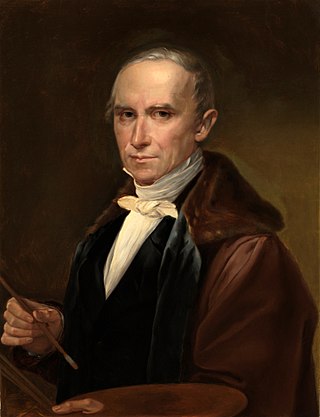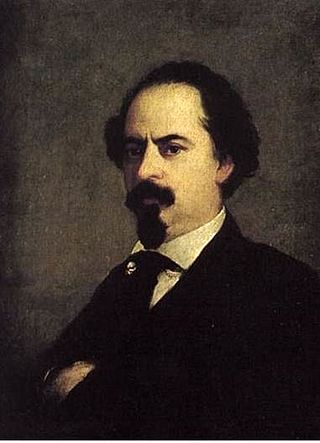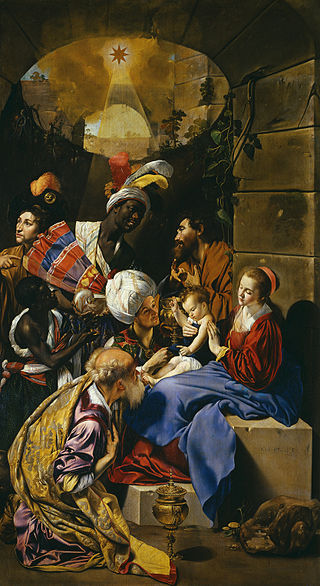Related Research Articles

The Museo del Prado, officially known as Museo Nacional del Prado, is the main Spanish national art museum, located in central Madrid. It houses collections of European art, dating from the 12th century to the early 20th century, based on the former Spanish royal collection, and the single best collection of Spanish art. Founded as a museum of paintings and sculpture in 1819, it also contains important collections of other types of works. The numerous works by Francisco Goya, the single most extensively represented artist, as well as by Hieronymus Bosch, El Greco, Peter Paul Rubens, Titian, and Diego Velázquez, are some of the highlights of the collection. Velázquez and his keen eye and sensibility were also responsible for bringing much of the museum's fine collection of Italian masters to Spain, now one of the largest outside of Italy.

Raimundo de Madrazo y Garreta was a Spanish painter from the Madrazo family of artists who worked in the Realistic style, although his later work shows signs of Rococo and Japanese influence. He was known primarily for his genre paintings and portraits. His grandfather was José de Madrazo, his father was the portrait painter Federico de Madrazo and his brother was Ricardo de Madrazo.

Pedro de Orrente was a Spanish painter of the early Baroque period who became one of the first artists in that part of Spain to paint in a Naturalistic style.

José de Madrazo y Agudo was a Spanish painter and engraver; one of the primary exponents of the Neoclassical style in Spain. He was the patriarch of a family of artists that included his sons Federico and Luis; and his grandsons, Raimundo and Ricardo.

Miguel Parra Abril was a Spanish artist who served as court painter to King Ferdinand VII. He is best known for his portraits and still-lifes; mostly of floral arrangements. The famous portrait painter, Vicente López Portaña, was his brother-in-law.

Antonio de Pereda y Salgado was a Spanish Baroque-era painter, best known for his still lifes.
The National Exhibition of Fine Arts was a regular event that took place in Spain from 1856 to 1968; usually in Madrid. These exhibitions were in the form of a competition, established by a Royal Decree from Queen Isabella II in 1853. It was the largest official exhibition of Spanish art.

The Wine of Saint Martin's Day is the largest painting by Pieter Bruegel the Elder. It is currently held in the Museo del Prado, Madrid, where it was identified as a Bruegel original in 2010. Like much of Bruegel's work it depicts peasant life, in this case a festival known as St. Martin's Day, which involves drinking the first wine of the season.

The Museum of Romanticism is an art museum in Madrid, Spain, devoted to Romanticism. It was inaugurated in 1924 as Museo Romántico. It is one of the National Museums of Spain and it is attached to the Ministry of Culture.

Carlos Sebastián Pedro Hubert de Haes was a Spanish painter from Belgium. He was noted for the Realism in his landscapes, and was considered to be the "first contemporary Spanish artist able to capture something of a particularly Spanish 'essence' in his work". He was cited along with Jenaro Perez Villaamil and Aureliano de Beruete as one of the three Spanish grand masters of landscape painting, the latter of which was his pupil.

Juan Fernández, nicknamed El Labrador, was a Spanish Baroque painter active between 1629 and 1636, specializing in still life painting.

The Adoration of the Magi is a very large oil painting by the Flemish Baroque painter Peter Paul Rubens. He first painted it in 1609 and later gave it a major reworking between 1628 and 1629 during his second trip to Spain. It is now in the Museo del Prado in Madrid.

Eugenio Lucas Velázquez was a Spanish painter in the Romantic style, known for genre and costumbrista scenes which often featured fantastic elements. Nineteenth-century sources refer to him as Eugenio Lucas Padilla, which has caused some confusion, although it seems reasonable to assume that Velázquez was an adopted name. Few of his paintings are signed, causing a problem with attribution.

Summer or The Threshing Floor is the largest cartoon painted by Francisco de Goya as a tapestry design for Spain's Royal Tapestry Factory. Painted from 1786 to 1787, it was part of his fifth series, dedicated to traditional themes and intended for the heir to the Spanish throne and his wife. The tapestries were to hang in the couple's dining room at the Pardo Palace.

Children in a Chariot is a 1779 painting by Francisco de Goya. It is part of the third series of cartoons he produced for tapestries at the Royal Palace of El Pardo; the tapestry in question was to be positioned over a door. The painting is in the Toledo Museum of Art.

Portrait of Infanta Isabella Clara Eugenia is a 1599 oil-on-canvas painting of Isabella Clara Eugenia by the Italian painter Sofonisba Anguissola, identified in 1992 by Maria Kusche. Owned by the Museo del Prado, it currently hangs in the Spanish Embassy in Paris.

The Pontevedra Museum is a museum in the Galician city of Pontevedra in Spain. It was founded by the Provincial Deputation of Pontevedra on 30 December 1927 and has six buildings for its exhibitions. It has permanent and temporary exhibition rooms. The museum's collections are multidisciplinary, classified into rooms for painting, sculpture, archaeology, decorative arts, engraving and ethnography.

The Adoration of the Magi or La Adoracion de los Reyes Magos is a painting by Juan Bautista Maíno in the Museo del Prado, in Madrid.

Gregorio Cruzada Villaamil was a Spanish art historian, interested in the art of Velasquez, Rubens, Goya, and all the art seized by the Spanish state during the Mendizábal confiscations.

La novillada, is a painting by Francisco de Goya, painted in 1780, when he was trying his hand at bullfighting. It is part of the fourth series of tapestry cartoons for the Prince of Asturias' antechamber in the Pardo Palace.
References
- ↑ 1865 inventory and catalog by Gregorio Cruzada Villaamil on archive.org
- El Museo de la Trinidad en el Prado, 2004 exhibition on the history of the Trinidad collection of the Prado, 2004